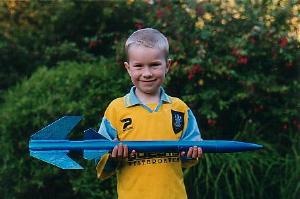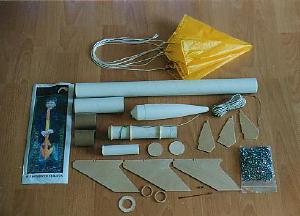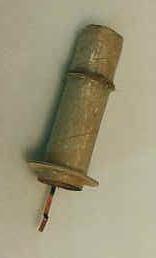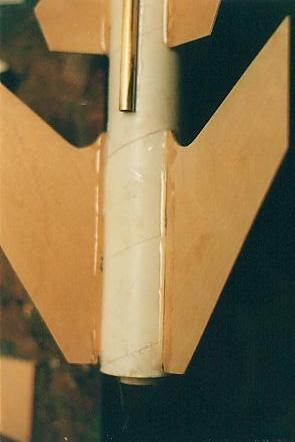| Manufacturer: | Physics of Flight  |

(
 Contributed - by Martin Sweeney - 01/14/03)
Contributed - by Martin Sweeney - 01/14/03) Brief:
An interesting looking kit - single stage 29 or 24mm motors with single stage
parachute recovery using a floating piston.
Modifications:
Recovery system, and motor mount, as described below.
 Construction:
Construction:
One of Missiles for Peacefull Purposes' creations - the Raptor is a truly cool
looking kit. I had seen various videos and pictures of the rockets and when
Physics of Flight started to make them, I wanted one. I had to wait a while
though, before actually getting one - I picked up mine at IRW 2002 from Rockets
and Things and had a look through the kit to see if I had all the parts. I was
actually missing a payload section eye bolt, one brass crimp and a motor mount
adapter centering ring, and started out on the build. The only disappointment
was the elastic shock cord, however this was kept, but extended to 12'.
First up was the motor mount (29mm inside diameter) which I made up with some two ton epoxy (the part that I least wanted to fail). It was all fairly simple stuff. The main airframe was BT-60 and the superb quality centering rings fitted a treat. I had to cut a notch in the top two centering rings for the steel cable shock cord and made a noose with it that was fitted between the middle and first centering ring, and then crimped. Just for safety I epoxied the shock cord noose to the motor mount.
 Whilst the epoxy
on the motor mount was curing, I set about marking the tube for the fin
positions. Unfortunately the fin marking guide didn't meet up where it was
supposed to on the tube, so I had to take the positions off another Raptor, I
did the standard marking on the tube with the door frame trick, which again
proved successful and I marked on the positions for the cutting. I didn't get
any further on the kit at International Rocket Week but I carried on back at
home on the Monday afterwards.
Whilst the epoxy
on the motor mount was curing, I set about marking the tube for the fin
positions. Unfortunately the fin marking guide didn't meet up where it was
supposed to on the tube, so I had to take the positions off another Raptor, I
did the standard marking on the tube with the door frame trick, which again
proved successful and I marked on the positions for the cutting. I didn't get
any further on the kit at International Rocket Week but I carried on back at
home on the Monday afterwards.
For the tube cutting I grabbed my Dremel and cut away happily, the width of the cutting disk being perfect for the gap of the brilliantly made CNC cut ply fins. I was quite pleased that the fins were "through the wall" as it would provide loads of added strength - perfect for what I plan to fly it on..
Before I epoxied the motor mount I made a small modification recommended to me by Richard Parkin; I drilled a small (1.5 mm) hole for a bolt and nut to be fixed through. The nut was glued on the non-visible side of the hole and the bolt would be used for holding the 24 mm motor adapter in place when flown in that configuration. The modification was very easy and will almost certainly be of great use in the future and in my opinion such an assembly should be included in the kit for this purpose.
 The Fins were
next; these are superb quality CNC cut ply and really fit the bill for a cool
looking rocket that is very strong. I sanded off all bits of shavings left by
the machining and sanded down the main faces, just for a little extra finish. I
also sanded the leading edge of the fins, for aerodynamics. I epoxied them onto
the motor mount with Devcon 2 ton epoxy and also attached the launch lug (a
brass PML one rather than the one included) with the same stuff. The launch lug
was later filleted and then smoothed off with a car body filler and the ends
beveled to roughly 45 degrees.
The Fins were
next; these are superb quality CNC cut ply and really fit the bill for a cool
looking rocket that is very strong. I sanded off all bits of shavings left by
the machining and sanded down the main faces, just for a little extra finish. I
also sanded the leading edge of the fins, for aerodynamics. I epoxied them onto
the motor mount with Devcon 2 ton epoxy and also attached the launch lug (a
brass PML one rather than the one included) with the same stuff. The launch lug
was later filleted and then smoothed off with a car body filler and the ends
beveled to roughly 45 degrees.
After the fins were set I filleted the fins with Devcon 2 ton epoxy and left them to dry. This was the longest part of assembly as I clamped the rocket into the vice and did each set of fillets (four at a time) so that they would not drip but be nice and smooth and not leave me having to get my hands covered in epoxy. With each fin set taking about forty five minutes to cure, this took some time.
Next was the Piston Ejection system. The instructions say to peel the top layer off the piston tube and soak CA into it and spread it about. This part has the capability to leave you stuck quite badly to the tube, so I used a pair of clips used for soldering to hold it whilst I did this part. Pliers would suffice. I think that this point should be included in the instructions. When the CA has dried and been sanded it gives a surprisingly shiny coat, but this does require quite some sanding to slide smoothly in the main tube. I found that the steel shock cord was too short to position the piston where it was suggested so I positioned it about 200 mm from the top of the main tube along the elastic shock cord and secured it in place with a knot on either side of the plywood plate and secured with epoxy, and then coated the whole plate and the parts where it touched the piston with epoxy.
I made the 24 mm adapter as instructed but the one centering ring that I had was too small for the 25 mm OD tube. This means that I had to strip off the outside layer of the tube as in the piston and strengthen with CA. The ring, even with sanding, was still a tight fit but I managed to fit it in eventually, and secured it with Devcon 2 ton epoxy.
I also put in the 24 mm engine hook and cut the slot in the large ring for the end of the adapter. I then marked on the location for the bolt for keeping the adapter in place by putting a nail in the hole drilled for the bolt and then lowering the adapter onto it, and then drilling on the point made.
Before painting, any holes and irregularities in the fillets were filled in with car body filler.
Finishing:
The instructions also include a 'painting suggestions' page, which quite
amusingly are printed in Black and white ;-) I opted for a nice metallic blue.
The rocket has no decals with it but the amazing and funky looks make up for
that....The ply fins do need filling before painting to stop paint seeping in
and spoiling the effect
Construction Rating: 3 out of 5
Flight:
I've so far only flown this rocket on a D12-5, it was a slow and dramatic
flight, only slightly underpowered. This will rock on a G, and will be flying
on one shortly hopefully :-)
Recovery:
The recovery is excellent, the floating piston chucks out the chute brilliantly
and the lack of the need for wadding is a huge plus.
Flight Rating: 4 out of 5
Overall Rating: 4 out of 5
Other Reviews
- Physics of Flight Raptor By Kevin Timmins
( Contributed - by Kevin Timmins) Brief: Twin Finned design by Zigi. Made by Physics of Flight. Supplied with 29mm Mount and a 24mm adaptor for lower powered flights. The fin design of this kit is superb!. The upswept lower fins just look cool! The kit is designed for both Piston & Nomes heatshield ejection (no wadding needed). Construction: Kit Contents: Resin Nose ...
 |
 |
Flights
 |
 |